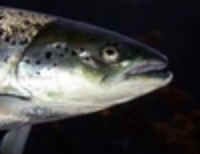Farmed Atlantic salmon can develop cataracts, which are defects of the eye. In severe cases, it leads to blindness, reduced feed intake and other negative effects. Research has shown that both composition of the feed and production conditions affect the development of cataracts.
"A recently published trial shows that farmed Atlantic salmon demonstrate a higher occurrence of mild cataracts in the sea-water stage if it is grown in oxygenated water in the freshwater stage, says Rune Waagbø", researcher at the Seafood Safety Research Programme at NIFES.
Oxygenation and Cataracts

In land-based facilities, freshwater is commonly oxygenated to compensate for a high fish density and a lower utilization of water. High fish densities lead to high oxygen consumption and higher levels of the exhalation gas carbon dioxide.
In this trial, smolt weighing about 50 grams were grown in 90, 112 or 125 per cent oxygen-saturated water for six weeks prior to transfer to sea-water.
The water in three of the groups had carbon dioxide (18 mg/l) in addition, while the water in another three groups was not added carbon dioxide.
These levels of gases in the water represent normal production conditions in land-based facilities for salmon smolt. The fish were raised on commercial feed.
"Cataracts were not observed in the fish prior to the trial, but a considerable number of fish developed mild cataracts after six weeks in the sea, "says Waagbø.
"Twice as many salmon from the group which was raised in oxygenated water developed cataracts in the sea-water stage compared to those which were raised in oxygenated water with added carbon dioxide".
Can Molecular Tools Explain Cataract Formation?
Oxidative stress is the most common cause of cataract development in humans. The effects are counteracted by antioxidants, among other things, that we find naturally in fruits and vegetables. Similarly, the salmon receives antioxidants from the feed.
"A fish that is stressed will produce specific proteins depending on a sequence in its genes. In this experiment, we investigated the expression of genes expressed by fish under oxidative stress."
"The results indicate that the genes encoding for antioxidant enzymes (Cu/Zn SOD and GST) and heat-shock protein (HSP70) had lower expression levels in fish exposed to oxygenated water.
This signifies that the protection from antioxidants is reduced during oxygenation and high growth rate. Earlier experiments have shown that the risk of cataracts increases with increased growth rate."
Collaborating partners: Bergen College University (Norway), Marine Harvest Norway, the University of Bergen and the National Veterinary Institute (Norway).
Note
Based on the scientific article: Waagbø, R., Hosfeld, C.D., Fivelstad, S., Olsvik, P.A., Breck, O., 2008. The impact of different water gas levels on cataract formation, muscle and lens free amino acids, and lens antioxidant enzymes and heat shock protein mRNA abundance in smolting Atlantic salmon, Salmo salar L. Comp Biochem Physiol, A149, 396-404. Rune Waagbø can be contacted at the Seafood Safety Research Programme. E-mail: rwa@nifes.no.
July 2008
